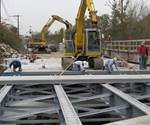ACMA releases standard specification for FRP composite utility poles
The guide is the first of its kind to promote standardization in fiber-reinforced composite utility poles.
The American Composites Manufacturers Association (ACMA; Arlington, Va., U.S.) released a new resource for promoting the standardization for the use of fiber-reinforced polymer (FRP) composites for electrical distribution, transmission and communication structure applications. The resource, called the “ANSI/ACMA Standard Specification for Fiber Reinforced Polymer Composites Utility Poles,” is the first of its kind from the ACMA and is available for purchase online in ACMA’s .
Developed by ACMA's Utility and Communication Structures Council (UCSC), the ANSI standard is intended to be a uniform reference document for electric utility engineers, and includes details regarding manufacture, assembly, and safe and correct installation of FRP poles. The document is meant ot enable widespread applications and a greater understanding of the differences between FRP composites and traditional materials like wood, concrete and steel. It covers the use of FRP utility poles throughout the product lifecycle, including design, material properties, manufacturing processes, quality control, assembly, and installation, as well as inspection parameters of direct embedded FRP utility poles.
"Prior to the development of this ANSI standard, in many cases, a line designer could only seek information provided by each manufacturer. The completion of the ANSI standard for FRP composite utility poles provides a trusted resource for utilities in North America and beyond," says John P. Busel, F.ACI, VP of ACMA's Composites Growth Initiative.
Additionally, the standard specifications highlight the benefits and advantages of FRP composite poles in the electric distribution and transmission infrastructure in North America. The resource establishes that FRP utility poles are lightweight, corrosion resistant, highly reliable, capable of excellent dielectric strength and have a long service life. FRP composite poles are also said to be the most environmentally sustainable choice for utility structures when used to replace chemically treated wood poles.
"This resource reinforces the importance of composites to provide durable, reliable and safe solutions for all industries and markets, including our nation's infrastructure,” says Tom Dobbins, ACMA president. “ACMA is committed to producing more standards in other key areas to increase the use of composite solutions in more industries. We believe greater knowledge and understanding of these amazing materials will ultimately lead to greater usage."
Related Content
-
Composites reinvent infrastructure
Celebrating National Composites Week, CW shares ways in which composites continue to evolve the way we approach infrastructure projects.
-
CCG meets customer demand with StormStrong utility pole lineup
Additional diameters build on the portfolio of resilient FRP pole structures for distribution and light pole customers.
-
Woven UD fabric enhances scalable carbon fiber options for infrastructure
CAMX 2025: Zoltek introduces PX35 woven UD fabric which bridges the gap between performance and affordability for retrofit and new build scenarios.
.jpg;width=70;height=70;mode=crop)


